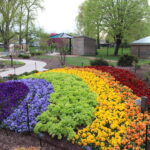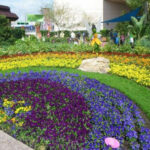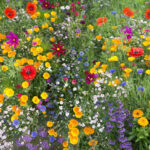Creating a rainbow garden is a delightful way to celebrate the beauty of nature through a spectrum of colors. This type of garden not only adds visual appeal but also brings a sense of joy and serenity. Here’s a step-by-step guide on how to design your very own rainbow garden.
1. Plan Your Palette
The first step in designing a rainbow garden is to plan your color palette. A traditional rainbow includes red, orange, yellow, green, blue, indigo, and violet. However, you can adjust this palette based on the plants available in your region and your personal preferences. Consider the following hues for your garden:
- Red: Roses, tulips, or geraniums.
- Orange: Marigolds, poppies, or zinnias.
- Yellow: Daffodils, sunflowers, or marigolds.
- Green: Ferns, hostas, or ornamental grasses.
- Blue: Hydrangeas, delphiniums, or cornflowers.
- Indigo: Irises, salvias, or morning glories.
- Violet: Lavender, pansies, or violets.
2. Assess Your Garden Space
Evaluate the space where you intend to create your rainbow garden. Consider the size, shape, and sunlight exposure of the area. A sunny location is ideal for most flowering plants, but you can also design a shaded rainbow garden with appropriate plant selections. Sketch a layout to visualize how the colors will flow from one to the next.
3. Prepare the Soil
Healthy soil is the foundation of a vibrant garden. Test your soil to determine its pH and nutrient levels. Amend the soil with compost or organic matter to ensure it is rich and well-draining. Each color zone might have specific needs, so tailor your soil preparation to the plants you’ve chosen for each section.
4. Choose and Arrange Your Plants
Selecting plants that bloom at the same time will create a continuous rainbow effect. When arranging your plants, consider their height and growth habits to ensure that taller plants do not overshadow shorter ones. Here’s a suggested arrangement:
- Front row (short plants): These plants should be less than a foot tall. Examples include pansies (violet), alyssum (yellow), and dwarf marigolds (orange).
- Middle row (medium plants): These plants range from 1 to 3 feet tall. Consider geraniums (red), coreopsis (yellow), and salvia (indigo).
- Back row (tall plants): These plants can grow over 3 feet tall. Examples include sunflowers (yellow), delphiniums (blue), and hollyhocks (various colors).
5. Create Color Zones
To create a true rainbow effect, group plants by color. Start with one end of the spectrum and gradually transition to the next. For a smooth flow, plant in overlapping bands or swaths rather than rigid lines. This will create a more natural and pleasing transition between colors.
6. Add Complementary Features
Enhance the rainbow effect with complementary garden features. Consider adding colorful garden ornaments, such as painted rocks or glass sculptures. You can also incorporate pathways or borders in neutral tones to frame the vibrant plantings. Water features like fountains or ponds can add an extra layer of beauty and tranquility to your garden.
7. Maintain Your Garden
Regular maintenance is crucial to keep your rainbow garden looking its best. Water your plants according to their needs, and be mindful of seasonal changes. Deadhead spent flowers to encourage more blooms and prevent the garden from looking untidy. Mulch around your plants to retain moisture and suppress weeds.
8. Enjoy the Blooms
The ultimate reward of a rainbow garden is the joy it brings. Take time to sit and enjoy the colors, watch the pollinators that visit, and share the beauty with friends and family. A rainbow garden is not only a feast for the eyes but also a haven for relaxation and reflection.
By following these steps, you can create a stunning rainbow garden that adds a splash of color and happiness to your outdoor space. Whether you’re an experienced gardener or a novice, this project is a wonderful way to connect with nature and indulge in the simple pleasures of life.
 Flower Love
Flower Love














